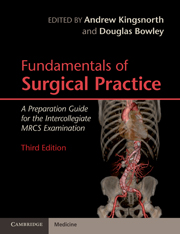Book contents
- Frontmatter
- Contents
- List of contributors
- Preface
- Section 1 Basic Sciences Relevant to Surgical Practice
- Section 2 Basic Surgical Skills
- Section 3 The Assessment and Management of the Surgical Patient
- Section 4 Perioperative Care of the Surgical Patient
- Section 5 Common Surgical Conditions
- 16 Assessment and early treatment of patients with trauma
- 17 Fundamentals of the central nervous system
- 18 Fundamentals of head and neck surgery
- 19 Fundamentals of thoracic surgery
- 20 Oesophago-gastric surgery
- 21 Fundamentals of hepatobiliary and pancreatic surgery
- 22 Fundamentals of endocrine surgery
- 23 Fundamentals of the breast
- 24 Lower gastrointestinal surgery
- 25 Fundamentals of the genitourinary system
- 26 Hernias
- 27 Fundamentals of vascular surgery
- 28 Fundamentals of orthopaedics
- 29 Fundamentals of plastic surgery
- 30 Surgical care of the paediatric patient
- 31 Fundamentals of organ transplantation
- Index
22 - Fundamentals of endocrine surgery
Published online by Cambridge University Press: 03 May 2011
- Frontmatter
- Contents
- List of contributors
- Preface
- Section 1 Basic Sciences Relevant to Surgical Practice
- Section 2 Basic Surgical Skills
- Section 3 The Assessment and Management of the Surgical Patient
- Section 4 Perioperative Care of the Surgical Patient
- Section 5 Common Surgical Conditions
- 16 Assessment and early treatment of patients with trauma
- 17 Fundamentals of the central nervous system
- 18 Fundamentals of head and neck surgery
- 19 Fundamentals of thoracic surgery
- 20 Oesophago-gastric surgery
- 21 Fundamentals of hepatobiliary and pancreatic surgery
- 22 Fundamentals of endocrine surgery
- 23 Fundamentals of the breast
- 24 Lower gastrointestinal surgery
- 25 Fundamentals of the genitourinary system
- 26 Hernias
- 27 Fundamentals of vascular surgery
- 28 Fundamentals of orthopaedics
- 29 Fundamentals of plastic surgery
- 30 Surgical care of the paediatric patient
- 31 Fundamentals of organ transplantation
- Index
Summary
Introduction
Endocrine surgery involves the treatment of diseases affecting endocrine organs or networks to achieve hormonal or anti-hormonal effects in the body. Since these organs are anatomically and physiologically diverse, lesions are often managed by surgical location rather than by generic endocrine surgeons. For example, upper gastrointestinal surgeons may treat pancreatic lesions, adrenal lesions may be resected by urologists and ENT surgeons may operate on the thyroid and parathyroids. This requires exemplary multidisciplinary interaction with endocrinologists, radiologists and pathologists, together with other essential members of the team.
Endocrine surgery has common principles and themes. Incongruities in homeostatic positive and negative feedback mechanisms produce systematic abnormalities, which can then be localized anatomically. Endocrine surgeons must deal with duality; physiology and morphology; function and form; over-activity and tumour formation.
A number of fascinating endocrine diseases, such as the MEN syndromes, are very rare indeed and have a status that belies their incidence; however, the principles of management are fundamental to endocrine surgery.
Thyroid
Introduction
Goitres are very common and are defined clinically as any enlargement or change in consistency of the thyroid gland. Examination by ultrasound will show about 40% of middle-aged females to have nodular change in their thyroids. The thyroid produces hormones that influence metabolism; normal euthyroid control is maintained by thyroid stimulating hormone (TSH) from the pituitary. Alterations and diseases can produce over-activity (toxicity or hyperthyroidism) or under-activity (myxoedema or hypothyroidism).
- Type
- Chapter
- Information
- Fundamentals of Surgical PracticeA Preparation Guide for the Intercollegiate MRCS Examination, pp. 378 - 391Publisher: Cambridge University PressPrint publication year: 2011

